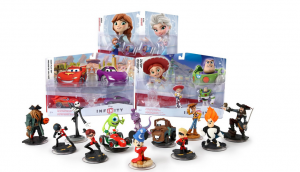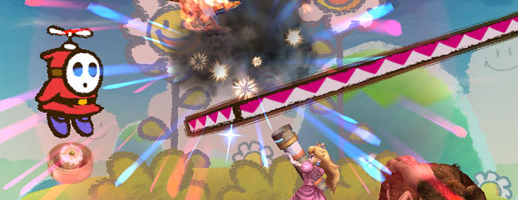A few weeks ago I wrote a post about the Amiibos’ success and I thought about the topic of branding and how there are two types of branding in any industry. For today’s post I want to talk about these two types in more detail and what they mean for developers and publishers when it’s time to promote.
Character Brands:
Character Branding refers to having a character that represents your brand or is the spokesperson; in other words, someone sees this character and immediately knows that they belong to company X. Some major examples would be Mario, Darth Vader, Bugs Bunny and even something like Tony the Tiger on the Frosted Flakes boxes.Character branding like this provides the consumer with something immediately identifiable and works for not just kids, but adults as well. If the character becomes popular enough, they can sell products simply by being featured or included, not just in their own brand.
Smash Brothers for the Wii-U is a good example of this and how it featured characters from other brands that weren’t a part of Nintendo, such as Pac-Man, Sonic, Ryu and Solid Snake (in the Wii version.) Because of how identifiable character brands are, they can lead to big bucks for a company that promotes them well. Besides just video games, toys and collectible figurines are a great example of the power of character brands, with many high quality collectibles of popular characters made over the years.
Obviously, talking about figurines and collectibles, we have to mention the Toys to Life genre and how character branding has been instrumental in its popularity. Lego Dimensions, Infinity and the Amiibos have great character branding to them by featuring characters that we all know and have grown up with. As I talked about in my previous piece on the Amiibos, finally having quality collectibles of Nintendo brands and characters was one of the major reasons why the line has been so popular.

Character branding has been a major success of the Toys to Life genre; as fans can collect figures of their favorite characters
The problem with character branding is that it is very hard to make a popular character, and we have seen this with all the different failures over the years; anyone remember Bubsy the cat?
Creating a character brand is something way too big to talk about in this piece and also the fact that there is no exact science to it. Sometimes a character that no one thought would work strikes a chord, or something that people thought would work turns out to be a bust.
Another issue is sustaining a character over time; as most companies want a character that can remain popular for years. During most of the last century, almost every product released had a corporate mascot to help attract kids and consumers to it. Today, those mascots that are still around have been reinvented for modern audiences with differing results.
The challenge comes in with how do you change a character to keep them relevant, but not change them too much that the character is no longer recognizable by fans? As a quick aside, we’ve seen this problem a lot with moving older cartoon characters and series to today, such as recent attempts at rebooting Loony Tunes and Tom and Jerry.
It’s also important to point out that when I use the term “character,” I’m not just talking about imaginary characters, as people can be a part of brands too. We’ve seen this rarely in the industry as most game developers prefer to be behind the scenes instead of on the game box, but some examples would be the Sid Meier branding from Firaxis or American Megee from awhile ago.
Up next, we’re going to take a look at Corporate Branding and the importance of logos.
Corporate Branding:
Corporate Branding is where the corporation itself is the brand instead of having a character or mascot representing it; some examples would be EA, Microsoft, Apple, Target and so much more. Here, the company itself is the brand that people are following, not a character or presence.
So instead of having a character, expect to see logos and catchphrases used to help brand the company; there is of course the infamous “EA Sports, it’s in the game,” tagline that EA had for awhile. Corporate Branding is a lot easier to do and maintain compared to Character Branding, because the brand itself is not tied to a persona. At most, a company may change a logo or catchphrase over the years and there are hundreds if not thousands of examples of that in the last few decades.
Corporate Branding can be more universal compared to character branding, where the company may have to make changes to characters depending on the country they’re targeting.
There is a famous example I read about how four fingered cartoon characters are banned in Japan due to their relation to the Yakuza and four fingers representing a lower social class. A logo as long as it avoids any overt symbolism on the other hand, can be transferred across nations pretty easily.
With that said, let’s talk about which form of branding is better and the answer is an obvious one.
Character Building:
Character Brands are a lot better than Corporate brands due to their increased functionality. With a brand logo like Pepsi, Amazon or EA, there is only so much you can do in terms of merchandising and promoting said product; no one wants to play with a toy shaped like a Pepsi can. Character Brands can be used for just about any kind of merchandise: shirts, toys, Video Games, medicine and I could go on for a few minutes.
With character brands, your consumer base includes both kids who want the toys/merchandise and collectors who are buying to either keep or sell. What makes the Toys to Life market so fantastic for brands like Lego, Disney and Nintendo, is the fact that they include a third market: Consumers who use them for their respective games.
Given the success of the Amiibos and the fact that Nintendo’s last big success of motion controls were copied by Sony and Microsoft, I’m sure some of you are thinking that there will be Toys to Life brands from them. However, it’s not that simple as they are both examples of corporate branding with nowhere near the amount of first party character brands compared to Nintendo.
Branded:
During the mid 90s through 00’s it felt like every console developer was trying to establish their own character brands, I remember Tak, Spyro, Crash Bandicoot and probably a few dozen more characters who have fallen by the wayside. There haven’t been too many pushes at character branding with the latest console generation which I find very interesting. During the 90s, character branding was a big deal and every console was trying to have the next Mario or Sonic. These days with the increased popularity of third party titles, third party developers have gone the branding route and let the major companies fight the corporate battle.
However, designing a great character and creating a Character Brand goes hand in hand and something that the Game Industry needs now are well designed characters. With talks of inclusivity in the industry, now is the time to start coming up with new and well defined characters to act as new brands for how the industry has changed. With that said, the big question of course is who is going to go first?


